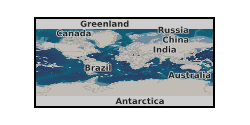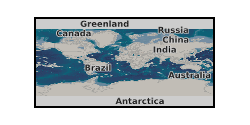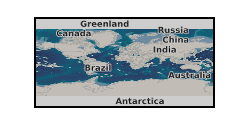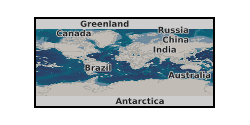Attenuation
Type of resources
Topics
Keywords
Contact for the resource
Provided by
Years
Formats
Representation types
Update frequencies
-

This excel spreadsheet contains P-wave and S-wave velocity and attenuation data calculated with a novel rock physics model for hydrate bearing sediments. The model has been published in: Marín-Moreno, H., S. K. Sahoo, and A. I. Best (2017), Theoretical modeling insights into elastic wave attenuation mechanisms in marine sediments with pore-filling methane hydrate, Journal of Geophysical Research: Solid Earth, 122(3), 1835-1847, doi:10.1002/2016JB013577.
-

This dataset is of laboratory ultrasonic shear wave measurements during methane hydrate formation in water saturated Berea sandstone using pulse echo method. We formed methane hydrate and took shear wave measurements during the formation process at different time interval. The hydrate saturation was calculated from measured pressure and temperature changes. This data set was used to show how shear wave velocity and attenuation can be used to estimate permeability of hydrate-bearing geological formations. We observed that velocity and attenuation both increase with hydrate saturation, with two peaks in attenuation at hydrate saturations of around 6% and 20% that correspond to changes in gradient of velocity. These laboratory experiments were conducted in National Oceanography Centre, Southampton by Sourav Sahoo with technical support provided by Laboratory Manager Laurence North. Sourav Sahoo interpreted the data. The hydrate formation process continued for few days and measurements were done mostly during daytime due to limited laboratory access during the night. This data set has been used for the paper published in Journal of Geophysical Research: Solid Earth (DOI 10.1029/2021JB022206)
-

This is a generic powerpoint showing results from azimuthal Q analysis of seismic data collected during the JC152 cruise (Bull et al., 2018). The presentation gives an introduction to the CHIMNEY project and study area. Data from 2 sources (GI guns and Surface sparker) are analysed, giving rise to measurements of attenuation as a function of two-wave time, azimuth and frequency at two locations. The data are inverted using a rock physics model, and probability distributions for matrix permeability and fracture size at the two sites are developed. Reference: Bull, J. M. (2018). Cruise Report – RRS James Cook JC152: CHIMNEY - Characterisation of Major Overburden Pathways above Sub-seafloor CO2 Storage Reservoirs in the North Sea Scanner and Challenger Pockmark Complexes,University of Southampton, 55 pp. Available at: https://eprints.soton.ac.uk/420257/ NERC Grant - Characterization of major overburden leakage pathways above sub-seafloor CO2 storage reservoirs in the North Sea (CHIMNEY)
-

The use of synthetic samples for rock physics experiments in the lab is a common practice for reservoir characterization and reservoir studies. This dataset gather ultrasonic P- and S-wave velocities and attenuations, electrical resistivity, axial and radial strains, permeability and mineralogical composition, of two synthetic and two natural sandstones, measured at variable realistic reservoir conditions of stress. The data were collected during an original study which aimed to assess the extent to which the measured properties between synthetic and natural sandstones are comparable. The work was accepted for publication in Geophysical Prospecting on the 01/10/2018, which can be accessed following the link: https://doi.org/10.1111/1365-2478.12699 Falcon-Suarez, I.H., Amalokwu, K., Robert, K., North, L., Best, A.I., Delgado-Martin, J., Callow, B., Sahoo, S.K. (accepted). Comparison of stress dependent geophysical, hydraulic and mechanical properties of synthetic and natural sandstones for reservoir characterisation and monitoring studies. Geophysical Prospecting
-

Physical properties of four serpentinite and four gabbro samples acquired respectively at the Southern Wall (IODP leg 357) and at the Central Dome (IODP leg 304-305) of the Atlantis Massif have been measured and analysed in the frame of a NERC UK-IODP moratorium research. The physical property measurements included simultaneous ultra-sonic wave velocities (compressional and shear wave velocities), attenuation, electrical resistivity and permeability under increasing and decreasing effective pressure ranging between 5 and 45 Mpa. Measurements were carried out using the experimental physical property measurement rig of the rock Physics laboratory of the National Oceanography Centre, Southampton, UK. The porosity and the density of the samples were estimated using their wet dry weight difference and the volume of the samples, under atmospheric pressure and room temperature. The aim of this research project was to learn about the physical properties of oceanic lower crustal and upper-mantle rocks and to find a geophysical method that would allow to distinguish between these rocks, remotely. The dataset has been acquired and interpreted by a science party including researchers from the University of Southampton and the National Oceanography Centre. The ultrasonic wave velocities, attenuation and the electrical resistivity for each sample and for each effective pressure (increasing from 5 to 45 with an interval of 10 MPa and decreasing from 45 to 5 with an interval of 20 MPa) are reported in this dataset. Permeability measurements could have been carried out only on 6 samples for which the permeability was high enough to be measured with the experimental rig.
 BGS Data Catalogue
BGS Data Catalogue